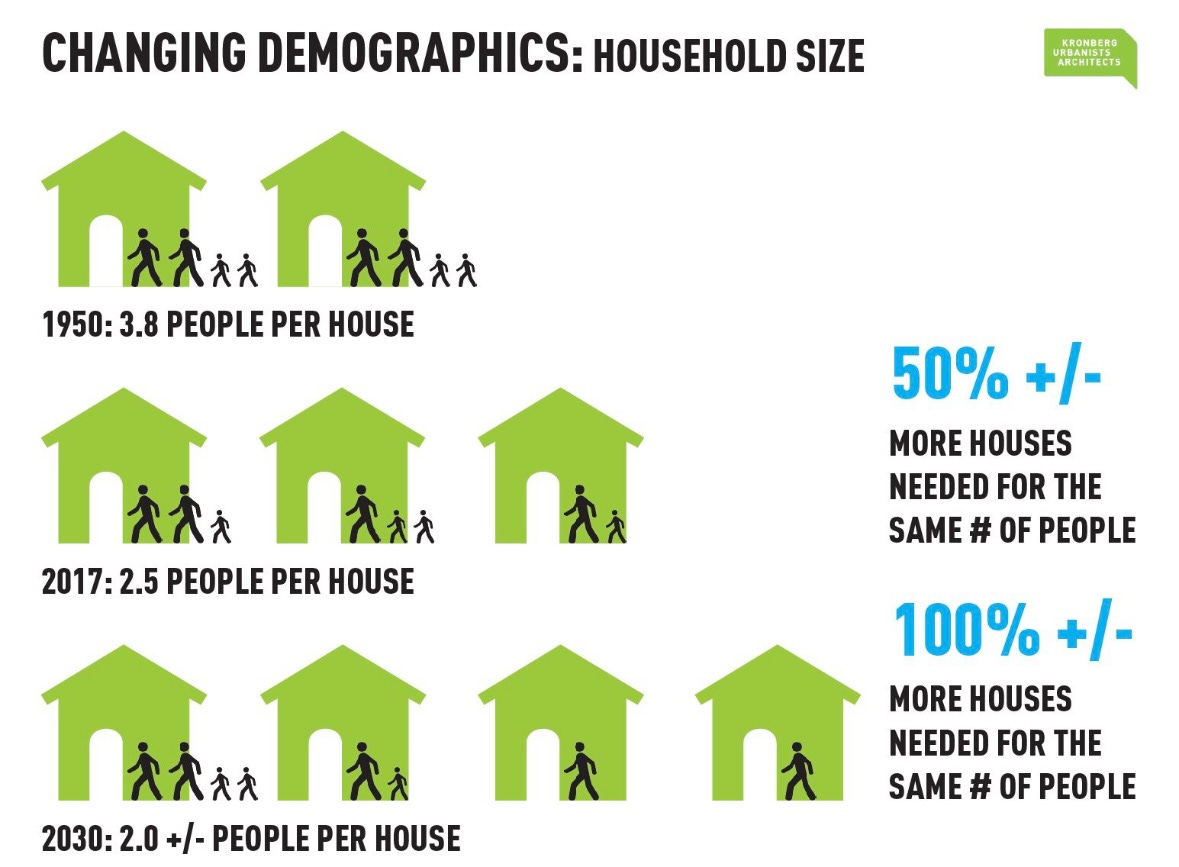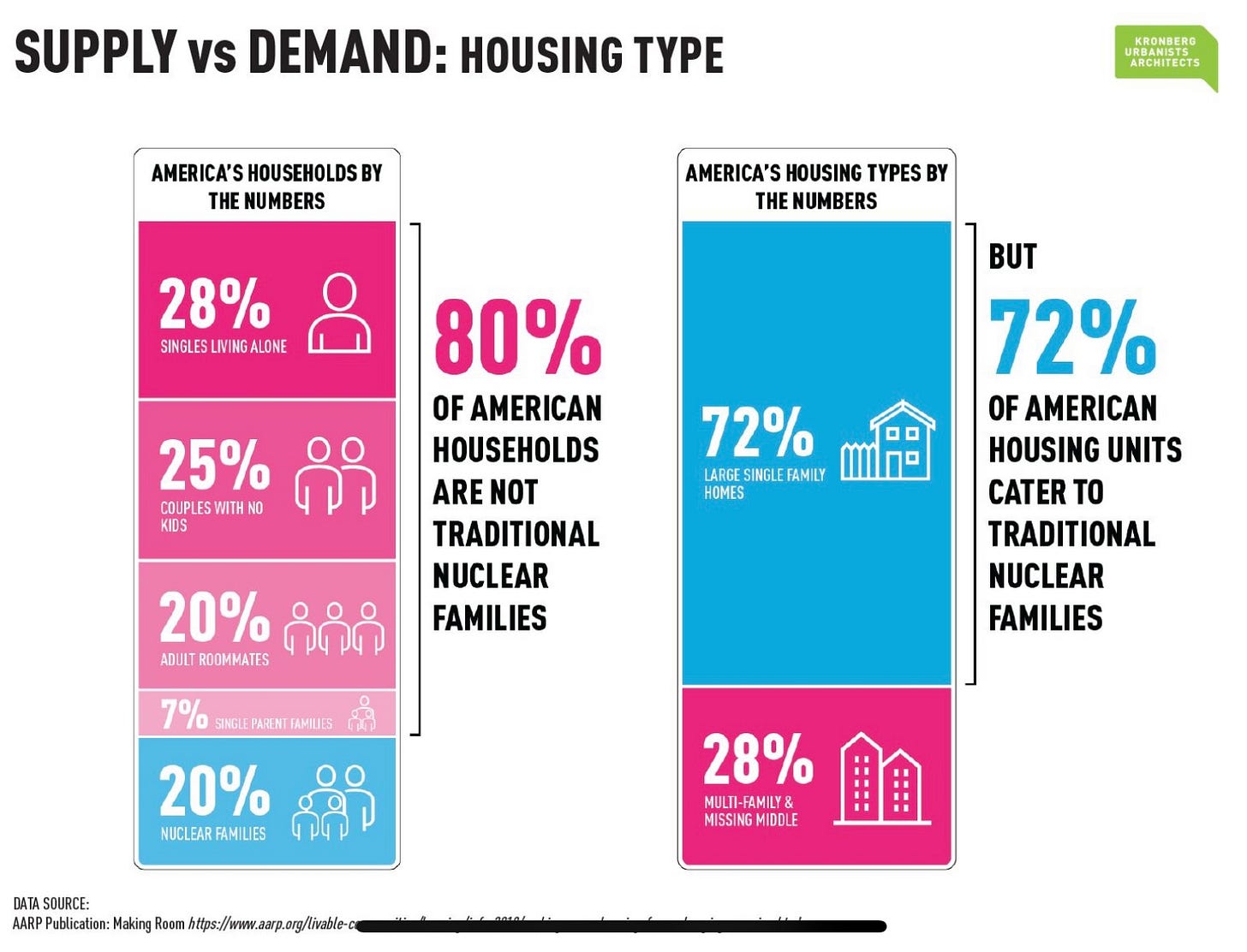America faces a paradox: we have both too few homes and a glut of empty bedrooms. While the United States grapples with a shortage of 3 million to 6.5 million homes nationwide (depending on who you ask), we simultaneously have a surplus of over 31 million bedrooms. This disconnect reveals an opportunity hiding in plain sight.
A guest suite is a great way to offer more housing choices in high opportunity neighborhoods while generating passive income for homeowners.
The Mismatch Between Homes and Households
The American household has transformed dramatically over the past several decades. The average household size has shrunk from 3.7 people in 1960 to just 2.5 in 2023. Yet during this same period, the average home size has more than doubled.
These statistics tell an important story:
In 1970, 40% of households were married couples with children
By 2023, only 20% of households fit this traditional family model
Today, 29% of households consist of single adults without children
Another 35% are couples without children at home
In total, approximately two-thirds of American households are either singles or couples without children at home. Despite this demographic reality, new housing continues to grow larger and more expensive, with the median cost to build a new single-family home now at $392,000 nationwide (in West Michigan the typical cost is closer to $375,000).
More often than not, homes with 3 or 4 bedrooms are occupied by just one or two people. Increasingly, those one or two people are over the age of 55 and may be thinking about accessibility within the next ten years.
This video from AARP offers a great explanation of how backyard cottages and secondary suites can support people who want to age-in-place.
Small Solutions to a Big Problem
What if millions of homeowners with spare space could easily create affordable housing options without building entirely new structures?
Converting existing space within a home to create a guest suite is remarkably cost-effective:
Creating a guest suite internal to existing space: $15,000 - $75,000
Creating a new unit that is attached to existing space: $40,000 - $100,000
Building a detached accessory dwelling unit (ADU): $150,000+
Building a new single-family home: $392,000 (median U.S. cost)
These guest suites—with separate entrances, private kitchenettes, and bathrooms—provide independence while utilizing space that already exists. This approach doesn't just address housing shortages; it can generate passive income for homeowners to offset mortgage payments or property taxes. For seniors on fixed incomes wanting to age in place, having a younger tenant who helps pay bills could be both financially and practically beneficial.
Regulatory Roadblocks
So why aren't more homeowners converting spare bedrooms into rental units? The primary barriers are a combination of local regulations and cultural expectations.
In many counties across America, secondary dwelling units are legal on less than 10% of residential land. For example, in Ottawa County, Michigan, secondary units without occupancy restrictions are permitted on about 6.7% of the land area in the County.
These restrictive zoning laws effectively prohibit one of the most practical and affordable solutions to our housing crisis.
Cultural Considerations
Beyond regulatory hurdles, many homeowners have legitimate questions about sharing their property:
How do we maintain privacy in shared spaces like yards?
What about noise concerns or visitors?
How will this affect our daily lives?
These questions should inform both design and management expectations. Secondary housing can be designed for privacy and separation from the primary home, or more integrated if the intended resident is a close friend or family member.
In this respect, there is an opportunity for an entire industry of professionals to help facilitate the creation of secondary units and backyard cottages. We need interior designers sharing knowledge about maximizing smaller spaces and creative floor plans. We need landscape architects sharing knowledge about how to arrange walkways, shrubs, and plantings to create an enjoyable environments while maintaining privacy for both homeowners and renters. And we need construction professionals sharing knowledge about sound dampening and basic code requirements.
To be honest, there is an incredible business opportunity in this space for a young self starter with good people skills, an eye for design, and connections to reliable contractors.
Resources for Homeowners and Communities
Fortunately, numerous resources exist to help homeowners navigate this opportunity:
Backdoor Revolution: The Definitive Guide to ADU Development by Kol Peterson
ADUs: The Perfect Housing Solution by Sheri Koones
AARP Livable Communities Resource Hub (All About ADUs)
For communities looking to update their regulations, model ordinances are available from organizations like AARP and the American Legislative Exchange Council.
A Modest but Meaningful Solution
Backyard cottages and guest units won't single-handedly solve America's housing shortage. Realistically, less than 5% of homeowners are likely to build one. But with 85 million homeowners in the U.S., even if only 1% create secondary units, that's nearly a million new housing options without purchasing additional land or significantly expanding our built environment.
If we apply this math to our local communities in West Michigan, and 1% of local homeowners decided to add a secondary unit, this would amount to more than 3,200 additional housing options.
These small solutions won't fix everything, but they represent a practical step toward addressing our housing needs while giving homeowners new options for utilizing their space and supplementing their income. However, local units of government must be proactive about getting out of the way of these innovations. Too often local planners believe that any potential consequence should be regulated away, but that’s simply not how the world works in reality. Imposing more stipulations and standards stifles the market of possibility. Allow property owners some flexibility to be creative while helping them to consider the tradeoffs of difference decisions. Be proactive and customer service oriented. Find ways to get to ‘yes’.
In a country with both too few homes and soooo many bedrooms, perhaps part of the answer is hiding right under our own roofs.






My husband and I have loved welcoming international students for over 20 years. The blessings are enormous. But I do want to admit that we have had one case of bedbug infestation, and are currently battling a cockroach infestation both of which I feel are the result of bringing luggage and household goods into our home. It’s a small price to pay, and I believe God has protected our home from worse problems, but I think it’s something to be aware of.